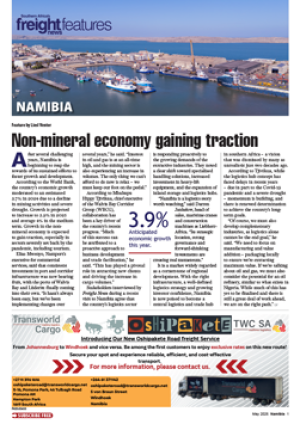The battle against the
department of transport
(DoT) proposal to reduce the
permissible single rear axle
mass for freight vehicles from
the current 9 000-kilograms to
8 000-kgs goes on apace, with
an urgent meeting having been
held between the Road Freight
Association (RFA) and the
department on December 9.
This, said the DoT, was a
move to save damage to the
already deteriorated secondary
road system – and included
the lower permissible mass, a
move to rail, and prohibiting
the road transport of certain
(as yet unnamed) commodities
on the secondary system.
But, while the DoT
appeared to be looking at
this as a possible answer,
the immediate reaction from
RFA CEO, Sharmini Naidoo,
was that it was not a feasible
solution. She added that it also
failed to recognise the true
reason for the deteriorating
roads. The department’s own
research, she said, showed
that “no funds are available to
continually sustain repair and
research – and that the network
has a five-year lifespan left
before collapse.”
But at least, after an initial
failure to get any sort of
official response from the DoT,
the December 9 meeting was
finally agreed to, according
to Gavin Kelly, technical and
operations manager of the
RFA.
“We met with two deputy
director-generals and were
informed that an internal
strategy meeting was being
held within the DoT on
December 17,” he told FTW.
“This was to look at the
axle-mass issue in terms of
Natmap (the national transport
masterplan), and we were
urgently requested to submit
our full detailed comments on
the issue for consideration at
the meeting.”
Despite the time restraints,
the RFA was able to submit a
lengthy document outlining its
feelings to Lanfranc Situma,
the deputy director-general
of integrated planning and
intersphere co-ordination.
The document initially
outlined what the RFA
judged as the reasons for the
continued disintegration of the
secondary road network.
It said that no periodic
maintenance, repair or
development had been done
over the past few years, and
that budget allocations for
road had been appropriated for
other programmes.
A second reason, it added,
was that dedicated road user
revenue streams (like fuel
levies, licence fees, permit
fees, general tax allocations,
fines) had not been utilised for
road maintenance.
The third reason cited a
lack of foresight and forward
planning at departmental
level – with the RFA pointing
out that many roads were not originally built for either the
weight or the traffic volumes
now experienced.
A final accusation is laid
at provincial level, and a
failure to prevent misuse
of the road structure by the
less-scrupulous amongst road
transporters. “Provinces,” said
the RFA document, “have not
effectively policed road traffic
matters.”
Kelly then summarised
seven proposed solutions for
FTW.
A first he directed at the
country’s road transport
management system (RTMS).
“Under this,” he said, “real
penalties for not complying
should be fed into a dedicated
road fund. Also, as part of
RTMS accreditation, a levy
should be included that can be
ring-fenced for roads.
“In addition, we feel that
operators should be offered
benefits for compliance – in
the form of tax rebates and the
like.”
The RFA is also adamant
that responsibility for roads
around the country is spread
over just too many government
and provincial bodies for
decent co-ordination of road
works to take place.
“All major transportation
routes (whether secondary
or primary),” said Kelly,
“should be handed over to the
SA National Roads Agency
Limited (Sanral). This would
ensure that routes are properly
maintained for safe and
efficient traffic flows.”
Steps should also be taken
to preserve supposed road
funding taxes and levies for
that purpose.
“All present and future road
user charges/revenue streams
(like fuel levies, licence fees,
permits, budget allocations,
traffic fines) must be ringfenced
for road requirements.”
Planned maintenance must
also become the norm, Kelly
added.
The RFA also feels that
there is a need to develop a
freight corridor programme.
“This,” said Kelly, “would
see most weight and volume
kept on the primary road
network – with secondary
roads only being used for
distribution where necessitated
by demand and supply.”
In an interview with FTW
in the first week of the year,
Kelly said that he had, until
then, no idea whether the
proposed internal strategy
meeting at the DoT had
actually taken place – nor how
the RFA’s documentation/
input and comment had been
received.
Hauliers await response to axle mass proposals
15 Jan 2010 - by Alan Peat
0 Comments
FTW - 15 Jan 10

15 Jan 2010
15 Jan 2010
15 Jan 2010
15 Jan 2010
15 Jan 2010
15 Jan 2010
15 Jan 2010
15 Jan 2010
15 Jan 2010
